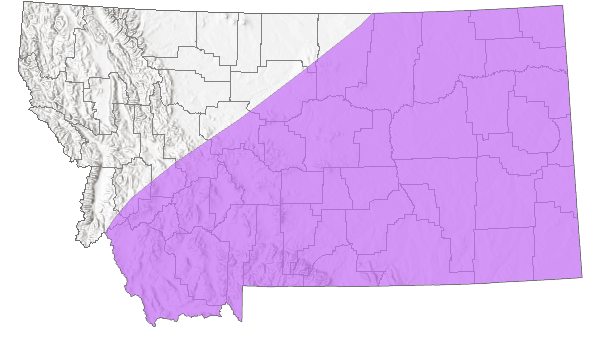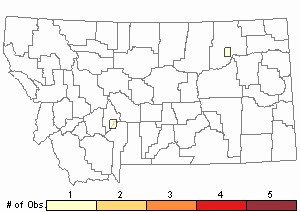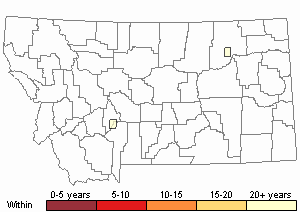View in other NatureServe Network Field Guides
NatureServe
Montana
Utah
Wyoming
Idaho
Wisconsin
British Columbia
South Carolina
Yukon
California
New York
Keeler's Spur-throat Grasshopper - Melanoplus keeleri
General Description
Taken from Hebard (1928), Brooks (1958), Helfer (1971), Vickery and Kevan (1985), Pfadt (2002), Capinera et al. (2004), Brust et al. (2008). A rather colorful, medium sized species, with a body color of brown, rusty brown dorsally, and yellow ventrally. The outer face of the hind femur possesses a blackish stripe dorsally, which narrows toward the knee and is not cut with any light bands, and is yellow below. The hind tibia is red, with lower black spines. The wings (tegmina) extend to or beyond the abdominal tip and have a row of dark spots.
Phenology
The Keeler's Spur-throat Grasshopper is a late hatching species. Overwinters in the egg stage. The nymphs hatch from early to late June. Adults are common in late July and early August to October, sometimes into November, depending upon weather (Brust et al. 2008, Capinera et al. 2004, Scott 2010, Vickery and Kevan 1985).
Diagnostic Characteristics
the following comes from Hebard (1928), Brooks (1958), Helfer (1971), Vickery and Kevan (1985), Pfadt (2002), Capinera et al. (2004), Brust et al. (2008), and Scott (2010). Male body length 17 to 29 mm, females 19 to 38 mm. The most distinctive diagnostic characteristic is the male’s genital cercus. It is bifurcate (distinctively forked) with the dorsal arm large, broad, rounded at the apex and the ventral arm slender and pointed.
This species is distinctive among the Melanoplus genera, but always examine the male genitalia for identification certainty. There are two recognized subspecies of M. keeleri. M. keeleri in the southeastern U.S. and M. keeleri luridus in the west (Hebard 1928, and Brooks 1958).
Species Range
Montana Range
Range Descriptions

 Native
Native
Range Comments
This species ranges widely across North America, from the Atlantic coast westward to the Great Basin of Utah and Nevada, and across the southern Canadian provinces of Quebec to Saskatchewan, and south to northeast Texas. In Montana, it has been recorded in 14 counties.
Observations in Montana Natural Heritage Program Database
Number of Observations: 2
(Click on the following maps and charts to see full sized version)
Map Help and Descriptions
Relative Density

Recency


 (Observations spanning multiple months or years are excluded from time charts)
(Observations spanning multiple months or years are excluded from time charts)
Habitat
This species inhabits a wide variety of grassland types. It is common in the tallgrass and taller mixed grass prairies, often near forests, and usually on sandy and gravelly soils.
Food Habits
The Keeler's Spur-throat Grasshopper feeds on a wide variety of forbs. Studies reveal that a minimum of 52 species are consumed, belonging to 17 plant families, plus 7 species of grasses and sedges. Forbs include
western ragweed, (
Ambrosia psilostachya),
white sagebrush, (
Artemisia ludoviciana),
Missouri goldenrod, (
Solidago missouriensis), Scurfpea, Aster, Sunflowers,
prickly lettuce, (
Lactuca serriola),
scarlet globemallow, (
Sphaeralcea coccinea), to name just a few. May feed on apple and plum trees (Brust et al. 2008, and Pfadt 2002).
Reproductive Characteristics
Nymphs pass through 5 instars over about 46 days. Courtship in this species is brief. The duration of copulation is unknown. Egg pod contain 20 to 22 eggs per pod (Pfadt 2002).
Stewardship Responsibility
References
- Literature Cited AboveLegend:
 View Online Publication
View Online Publication Brooks, A.R. 1958. Acridoidea of Southern Alberta, Saskatchewan, and Manitoba (Orthoptera). The Canadian Entomologist (Supplement 9) 90:5-92.
Brooks, A.R. 1958. Acridoidea of Southern Alberta, Saskatchewan, and Manitoba (Orthoptera). The Canadian Entomologist (Supplement 9) 90:5-92. Brust, M.L, W.W. Hoback, and R.J. Wright. 2008. The Grasshoppers of Nebraska. Lincoln, NB: University of Nebraska Extension Service, APHIS.
Brust, M.L, W.W. Hoback, and R.J. Wright. 2008. The Grasshoppers of Nebraska. Lincoln, NB: University of Nebraska Extension Service, APHIS. Brust, M.L., W.W. Hoback, and R.J. Wright. 2008. A Synopsis of Nebraska Grasshopper Distributions. Journal of the Kansas Entomological Society 81(3):208-255.
Brust, M.L., W.W. Hoback, and R.J. Wright. 2008. A Synopsis of Nebraska Grasshopper Distributions. Journal of the Kansas Entomological Society 81(3):208-255. Capinera, J.L., R.D. Scott, and T.J. Walker. 2004. Field Guide to Grasshoppers, Katydids, and Crickets of the United States. Ithaca, NY. Cornell University Press.
Capinera, J.L., R.D. Scott, and T.J. Walker. 2004. Field Guide to Grasshoppers, Katydids, and Crickets of the United States. Ithaca, NY. Cornell University Press. Hebard, M. 1928. The Orthoptera of Montana. Proceedings of the Academy of Natural Sciences of Philadelphia, Vol. 80:211-306.
Hebard, M. 1928. The Orthoptera of Montana. Proceedings of the Academy of Natural Sciences of Philadelphia, Vol. 80:211-306. Helfer, J.R. 1971. How to Know the Grasshoppers, Crickets, Cockroaches, and Their Allies. Revised edition (out of print), Mineola, NY: Dover Publications.
Helfer, J.R. 1971. How to Know the Grasshoppers, Crickets, Cockroaches, and Their Allies. Revised edition (out of print), Mineola, NY: Dover Publications. Pfadt, R.E. 2002. Field Guide to Common Western Grasshoppers, 3rd edition. Laramie, WY: Wyoming Agricultural Experiment Station, Bulletin 912, modified by S. Schell and S. Schell for electronic publication. Accessed 19 February 2020. http://www.uwyo.edu/entomology/grasshoppers/field-guide/index.html#fieldguidetoc
Pfadt, R.E. 2002. Field Guide to Common Western Grasshoppers, 3rd edition. Laramie, WY: Wyoming Agricultural Experiment Station, Bulletin 912, modified by S. Schell and S. Schell for electronic publication. Accessed 19 February 2020. http://www.uwyo.edu/entomology/grasshoppers/field-guide/index.html#fieldguidetoc Scott, R.D. 2010. Montana Grasshoppers, Katydids, and Crickets A Pictorial Field Guide to the Orthoptera. MagpieMTGraphics, Billings, MT.
Scott, R.D. 2010. Montana Grasshoppers, Katydids, and Crickets A Pictorial Field Guide to the Orthoptera. MagpieMTGraphics, Billings, MT. Vickery, V. R. and D. K. M. Kevan. 1985. The grasshopper, crickets, and related insects of Canada and adjacent regions. Biosystematics Research Institute, Ottawa, Ontario. Publication Number 1777. 918 pp.
Vickery, V. R. and D. K. M. Kevan. 1985. The grasshopper, crickets, and related insects of Canada and adjacent regions. Biosystematics Research Institute, Ottawa, Ontario. Publication Number 1777. 918 pp.
- Additional ReferencesLegend:
 View Online Publication
View Online Publication
Do you know of a citation we're missing? Anderson, N.L. 1951. Field studies on the biology of range grasshoppers of southeastern Montana. M.Sc. Thesis. Bozeman, Montana: Montana State University. 96 p.
Anderson, N.L. 1951. Field studies on the biology of range grasshoppers of southeastern Montana. M.Sc. Thesis. Bozeman, Montana: Montana State University. 96 p. Anderson, N.L. 1962. Grasshopper-vegetation relationships on Montana grasslands. Ph.D Dissertation. Bozeman, Montana: Montana State University. 73 p.
Anderson, N.L. 1962. Grasshopper-vegetation relationships on Montana grasslands. Ph.D Dissertation. Bozeman, Montana: Montana State University. 73 p. Kirk, K. and C.R. Bomar. 2005. Guide to the grasshoppers of Wisconsin. Madison, WI: Wisconsin Department of Natural Resources, Bureau of Integrated Science Services PUB-SS-1008. 154 p.
Kirk, K. and C.R. Bomar. 2005. Guide to the grasshoppers of Wisconsin. Madison, WI: Wisconsin Department of Natural Resources, Bureau of Integrated Science Services PUB-SS-1008. 154 p.
- Web Search Engines for Articles on "Keeler's Spur-throat Grasshopper"
- Additional Sources of Information Related to "Insects"





